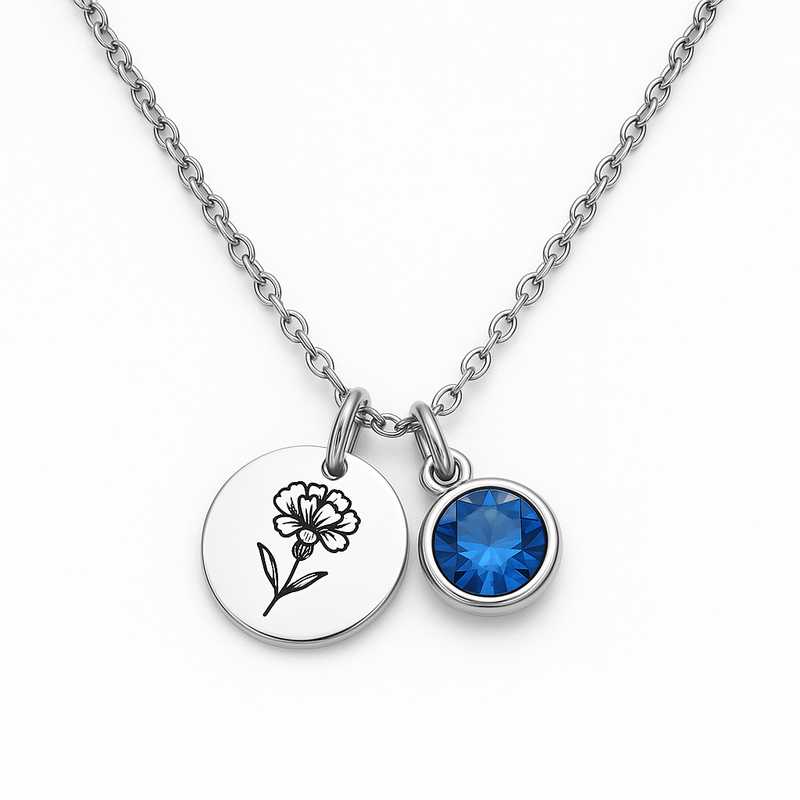Engineered Brilliance: Birthstone Charms with Precision Stainless Craft

Explore 304 vs 316L Stainless Steel, Laser Cutting, Eco-Processes & OEM/ODM Charm Innovations
Introduction: The Fusion of Aesthetics and Engineering
In the world of stainless steel jewelry, beauty alone isnt enoughespecially for B2B buyers seeking high-quality, sustainable, and scalable OEM/ODM solutions. The birthstone flower charm necklace has emerged as an evergreen best-seller across private labels, gifting companies, and fashion brands. But the true magic lies in the materials and technologies behind these pieces. This article dissects the advanced manufacturing techniques, material selection, and eco-conscious processes that elevate these charms beyond simple accessoriestransforming them into engineered masterpieces.
Whether youre customizing collections for retailers or developing signature designs for global clients, understanding the structural nuances of stainless steel (particularly 304 vs 316L), as well as cutting-edge production methods like laser cutting, hydraulic pattern stamping, and green electroplating, will help you make smarter sourcing decisions.
Material Showdown: 304 vs 316L Stainless Steel in Jewelry Applications
304 and 316L stainless steel are both prized for their luster, strength, and anti-tarnish propertiesbut they differ significantly in performance, especially under harsh conditions.
Corrosion Resistance
- 304 Stainless Steel: Excellent resistance to oxidation and corrosion in standard environments such as humid climates or frequent skin contact. Ideal for everyday jewelry not exposed to high salinity or chemicals.
- 316L Stainless Steel: Superior resistance due to its 2-3% molybdenum content. Exceptionally durable in coastal regions, spa products, or medical-grade scenarios where exposure to sweat, seawater, or body fluids is continuous.
Application Scenarios
- 304 Steel Use Case: In mass-produced seasonal fashion charms, where budget control is key and the jewelry is unlikely to face aggressive elements.
- 316L Steel Use Case: For premium OEM orders, including luxury flower-birthstone hybrids, wellness jewelry, or high-contact lifestyle pieces (e.g., gym wearables, baby-safe charms).
Choosing the right grade impacts not just product longevity but also brand perception. Clients who demand hypoallergenic and enduring jewelry increasingly require 316L as a default.
Precision Aesthetics: Laser Cutting & Micro-Hydraulics in Charm Shaping
Customization in jewelry is now a matter of microns. Modern OEM facilities utilize advanced fiber laser cutting machines capable of etching intricate floral and gemstone seat patterns with zero mechanical distortion. The results: sharp petal curves, clean geometric symmetry, and consistent tolerances across thousands of units.
Why Laser Cutting Wins
- Heat-free precision: Unlike traditional mechanical cutters, laser doesn’t deform the metal, keeping the charms surface smooth and lustrous.
- Speed & Efficiency: Up to 500 pieces/hour for complex charm silhouettesideal for bulk ODM delivery schedules.
- Design Complexity: Enables 3D hollow floral patterns or layered cutouts without extra assembly steps.
Hydraulic Processes
For volume depth and tactile texture, micro-hydraulic stamping delivers embossed veins on petals or recessed gemstone beds. Paired with precision dies, it produces crisp, permanent impressions resistant to fading. This process is essential for floral designs where subtle relief work adds luxury character.
Eco-Conscious Manufacturing: Green Electroplating & Material Recovery
Sustainability isn’t a buzzwordits an expectation, particularly in OEM contracts where traceability and ESG metrics matter.
Eco-Electroplating Techniques
- Trivalent Chromium Baths: Replaces hexavalent chromium with safer alternatives, reducing toxicity by over 95% while achieving the same mirror finish and durability.
- Closed-Loop Water Filtration: Water used in plating tanks is recycled and re-filtered for reuse, cutting wastewater discharge by up to 70%.
Waste Material Reclamation
During laser cutting and stamping, offcuts and shavings of stainless steel are collected in real time. These scraps are remelted or sold to suppliers, minimizing landfill waste. In 2024, one of our OEM clients reported 25% reduction in raw material costs via this closed-loop strategy.
Energy Monitoring and Certifications
Facilities using programmable energy monitoring systems can track consumption per charm batch, providing data for clients pursuing LEED-certified packaging or carbon-offset production. Environmental documentation is increasingly a key deliverable in OEM contracts, especially for European partners.
Surface Treatments & Corrosion Pattern Control
Not all corrosion is badcontrolled oxidation patterns are emerging as a design feature in some niche birthstone lines. When paired with natural patinas, brushed finishes, or heat-tinted steel, charms take on an antique or organic look.
Techniques in Use
- Satin brushing: Matte finish that highlights floral relief while hiding minor wear over time.
- Ion Plating (IP): Vacuum-based bonding of color layers (rose gold, black, rainbow) that are 58x more durable than wet plating.
- Laser Texturing: Microscopic etching to create visual complexity without altering overall weight or dimensions.
OEM clients often specify a blend of these finishes to offer tiered product lines: budget (brushed), mid-range (IP coated), and premium (oxidation art pieces).
OEM/ODM Customization Trends: What B2B Buyers Want in 2025
Manufacturers catering to the birthstone charm segment must now think beyond basic specs. B2B buyers demand modular design options, customizable charm mounts, and fast-swap engraving templates for localization or branding.
Trending OEM Requests
- Interchangeable Base Designs: Flower charm mounts with snap-fit gemstone slots to accommodate monthly color variations.
- QR-code Engravings: Popular for giftable charms, linking to personalized messages or authentication certificates.
- Mixed-Media Assemblies: Blending stainless steel with ceramic, resin, or glass petals for hybrid tactile aesthetics.
Clients increasingly expect 3D mockup services and on-demand prototyping. Facilities offering in-house CNC mold crafting and fast resin casting have a competitive edge, particularly for mid-volume ODM orders.
Conclusion: Partnering in Precision for a More Brilliant Future
Whether you’re launching a premium collection or refreshing a fast-moving seasonal line, the right materials and manufacturing technologies make all the difference. With smart selection between 304 and 316L stainless steel, precision-enhancing tools like laser cutters, and green practices that elevate your brand’s ESG credibility, youre not just making jewelryyoure crafting legacies.
Looking for a precision-driven OEM/ODM partner for your next charm line? Lets co-create brilliance. Contact us today for a sample kit or engineering consultation.
